2016 NISSAN 370Z COUPE coolant
[x] Cancel search: coolantPage 357 of 428

8-8Maintenance and do-it-yourself
The engine cooling system is filled at the factory
with a pre-diluted mixture of 50% Genuine
NISSAN Long Life Antifreeze/Coolant (blue) and
50% water to provide year-round anti-freeze
and coolant protection. The antifreeze solution
contains rust and corrosion inhibitors. Additional
engine cooling system additives are not neces-
sary.
WARNING
.Never remove the radiator or cool-
ant reservoir cap when the engine is
hot. Wait until the engine and
radiator cool down. Serious burns
could be caused by high pressure
fluid escaping from the radiator.
See precautions in “If your vehicle
overheats” (P.6-16) of this manual.
. The radiator is equipped with a
pressure type radiator cap. To pre-
vent engine damage, use only a
genuine NISSAN radiator cap.
CAUTION
.Never use any cooling system ad-
ditives such as radiator sealer. Ad-
ditives may clog the cooling system
and cause damage to the engine,
transmission and/or cooling sys-
tem.
. When adding or replacing coolant,
be sure to use only Genuine
NISSAN Long Life Antifreeze/Cool-
ant (blue) or equivalent. Genuine
NISSAN Long Life Antifreeze/Cool-
ant (blue) is pre-diluted to provide
antifreeze protection to �í348 F
(�í378C) . If additional freeze protec-
tion is needed due to weather where
you operate your vehicle, add Gen-
uine NISSAN Long Life Antifreeze/
Coolant (blue) concentrate follow-
ing the directions on the container.
If an equivalent coolant other than
Genuine NISSAN Long Life Anti-
freeze/Coolant (blue) is used, fol-
low the coolant manufacturer’s
instructions to maintain minimum
antifreeze protection to �í348 F
(�í378C) . The use of other types of
coolant solutions other than Genu- ine NISSAN Long Life Antifreeze/
Coolant (blue) or equivalent may
damage the engine cooling system.
. The life expectancy of the factory-fill
coolant is 105,000 miles (168,000
km) or 7 years. Mixing any other
type of coolant other than Genuine
NISSAN Long Life Antifreeze/Cool-
ant (blue) , including Genuine
NISSAN Long Life Antifreeze/Cool-
ant (green) , or the use of non-
distilled water will reduce the life
expectancy of the factory-fill cool-
ant. Refer to the NISSAN Service
and Maintenance Guide for more
details.
ENGINE COOLING SYSTEM
Page 358 of 428

JVM0087X
CHECKING ENGINE COOLANT LEVEL
Check the coolant levelin the reservoir when
the engine is running and after it reaches
normal operating temperature. If the coolant
level is below the MIN level
*2, add coolant up
to the MAX level
*1. If the reservoir is empty,
check the coolant level in the radiator when
the engine is cold. If there is insufficient
coolant in the radiator, fill the radiator with
coolant up to the radiator filler cap above the
radiator upper hose opening and also add it to
the reservoir up to the MAX level
*1. Put on the
filler cap above the radiator upper hose and with
the reservoir cap open, start the engine. Run the
engine until it reaches normal operating tem- perature. Add coolant up to the MAX level
*1.
Tighten the cap securely after adding engine
coolant.
If the cooling system requires coolant
frequently, have it checked by a NISSAN
dealer.
CHANGING ENGINE COOLANT
Major cooling system repairs should be per-
formed by a NISSAN dealer. The service
procedures can be found in the appropriate
NISSAN Service Manual.
Improper servicing can result in reduced
heater performance and engine overheat-
ing.
WARNING
. To avoid the danger of being
scalded, never change the coolant
when the engine is hot.
. Never remove the radiator cap when
the engine is hot. Serious burns
could be caused by high pressure
fluid escaping from the radiator.
. Avoid direct skin contact with used
coolant. If skin contact is made,
wash thoroughly with soap or hand
cleaner as soon as possible. .
Keep coolant out of reach of chil-
dren and pets.
Engine coolant must be disposed of properly.
Check your local regulations.
Maintenance and do-it-yourself8-9
Page 364 of 428
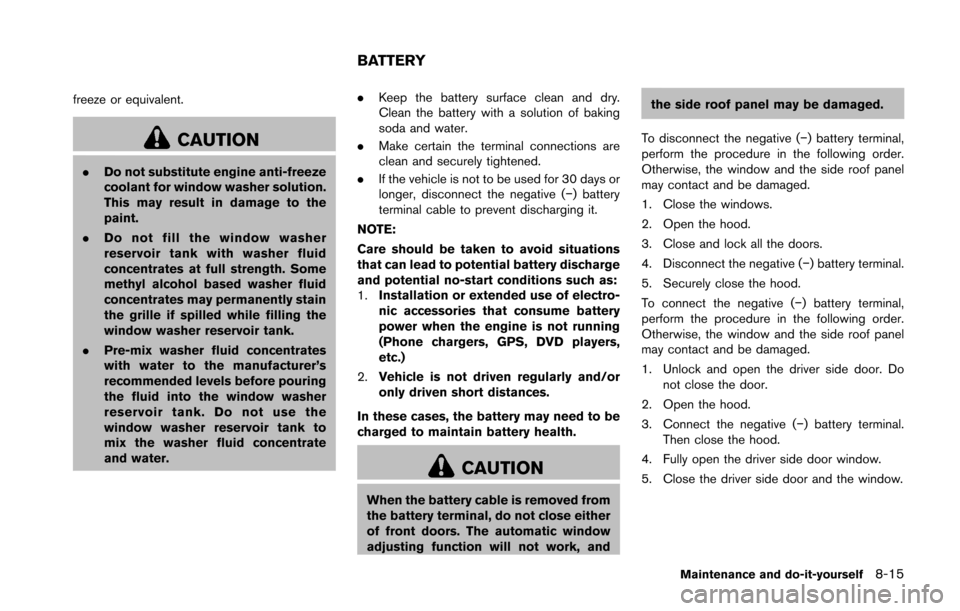
freeze or equivalent.
CAUTION
.Do not substitute engine anti-freeze
coolant for window washer solution.
This may result in damage to the
paint.
. Do not fill the window washer
reservoir tank with washer fluid
concentrates at full strength. Some
methyl alcohol based washer fluid
concentrates may permanently stain
the grille if spilled while filling the
window washer reservoir tank.
. Pre-mix washer fluid concentrates
with water to the manufacturer’s
recommended levels before pouring
the fluid into the window washer
reservoir tank. Do not use the
window washer reservoir tank to
mix the washer fluid concentrate
and water. .
Keep the battery surface clean and dry.
Clean the battery with a solution of baking
soda and water.
. Make certain the terminal connections are
clean and securely tightened.
. If the vehicle is not to be used for 30 days or
longer, disconnect the negative ( �í) battery
terminal cable to prevent discharging it.
NOTE:
Care should be taken to avoid situations
that can lead to potential battery discharge
and potential no-start conditions such as:
1. Installation or extended use of electro-
nic accessories that consume battery
power when the engine is not running
(Phone chargers, GPS, DVD players,
etc.)
2. Vehicle is not driven regularly and/or
only driven short distances.
In these cases, the battery may need to be
charged to maintain battery health.
CAUTION
When the battery cable is removed from
the battery terminal, do not close either
of front doors. The automatic window
adjusting function will not work, and the side roof panel may be damaged.
To disconnect the negative (�í) battery terminal,
perform the procedure in the following order.
Otherwise, the window and the side roof panel
may contact and be damaged.
1. Close the windows.
2. Open the hood.
3. Close and lock all the doors.
4. Disconnect the negative (�í) battery terminal.
5. Securely close the hood.
To connect the negative (�í) battery terminal,
perform the procedure in the following order.
Otherwise, the window and the side roof panel
may contact and be damaged.
1. Unlock and open the driver side door. Do not close the door.
2. Open the hood.
3. Connect the negative (�í) battery terminal. Then close the hood.
4. Fully open the driver side door window.
5. Close the driver side door and the window.
Maintenance and do-it-yourself8-15
BATTERY
Page 393 of 428
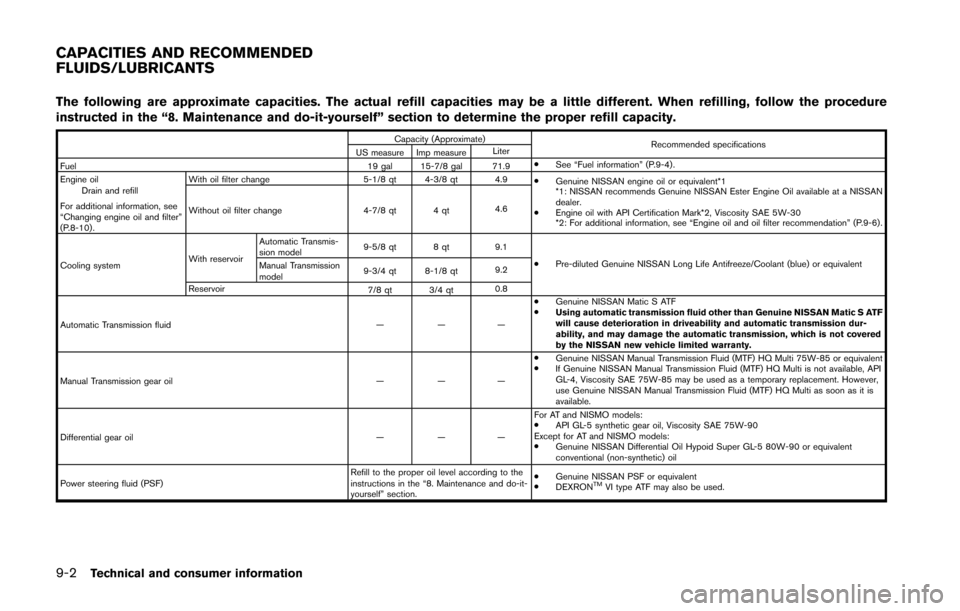
9-2Technical and consumer information
The following are approximate capacities. The actual refill capacities may be a little different. When refilling, follow the procedure
instructed in the “8. Maintenance and do-it-yourself” section to determine the proper refill capacity.
Capacity (Approximate)Recommended specifications
US measure Imp measure Liter
Fuel 19 gal 15-7/8 gal 71.9.
See “Fuel information” (P.9-4) .
Engine oil Drain and refill
For additional information, see
“Changing engine oil and filter”
(P.8-10). With oil filter change
5-1/8 qt 4-3/8 qt 4.9
.
Genuine NISSAN engine oil or equivalent*1
*1: NISSAN recommends Genuine NISSAN Ester Engine Oil available at a NISSAN
dealer.
. Engine oil with API Certification Mark*2, Viscosity SAE 5W-30
*2: For additional information, see “Engine oil and oil filter recommendation” (P.9-6) .
Without oil filter change
4-7/8 qt 4 qt4.6
Cooling system With reservoirAutomatic Transmis-
sion model
9-5/8 qt 8 qt
9.1
.Pre-diluted Genuine NISSAN Long Life Antifreeze/Coolant (blue) or equivalent
Manual Transmission
model 9-3/4 qt 8-1/8 qt
9.2
Reservoir 7/8 qt 3/4 qt0.8
Automatic Transmission fluid ———.
Genuine NISSAN Matic S ATF
. Using automatic transmission fluid other than Genuine NISSAN Matic S ATF
will cause deterioration in driveability and automatic transmission dur-
ability, and may damage the automatic transmission, which is not covered
by the NISSAN new vehicle limited warranty.
Manual Transmission gear oil ———.
Genuine NISSAN Manual Transmission Fluid (MTF) HQ Multi 75W-85 or equivalent
. If Genuine NISSAN Manual Transmission Fluid (MTF) HQ Multi is not available, API
GL-4, Viscosity SAE 75W-85 may be used as a temporary replacement. However,
use Genuine NISSAN Manual Transmission Fluid (MTF) HQ Multi as soon as it is
available.
Differential gear oil ———For AT and NISMO models:
.
API GL-5 synthetic gear oil, Viscosity SAE 75W-90
Except for AT and NISMO models:
. Genuine NISSAN Differential Oil Hypoid Super GL-5 80W-90 or equivalent
conventional (non-synthetic) oil
Power steering fluid (PSF) Refill to the proper oil level according to the
instructions in the “8. Maintenance and do-it-
yourself” section..
Genuine NISSAN PSF or equivalent
. DEXRON
TMVI type ATF may also be used.
CAPACITIES AND RECOMMENDED
FLUIDS/LUBRICANTS
Page 421 of 428
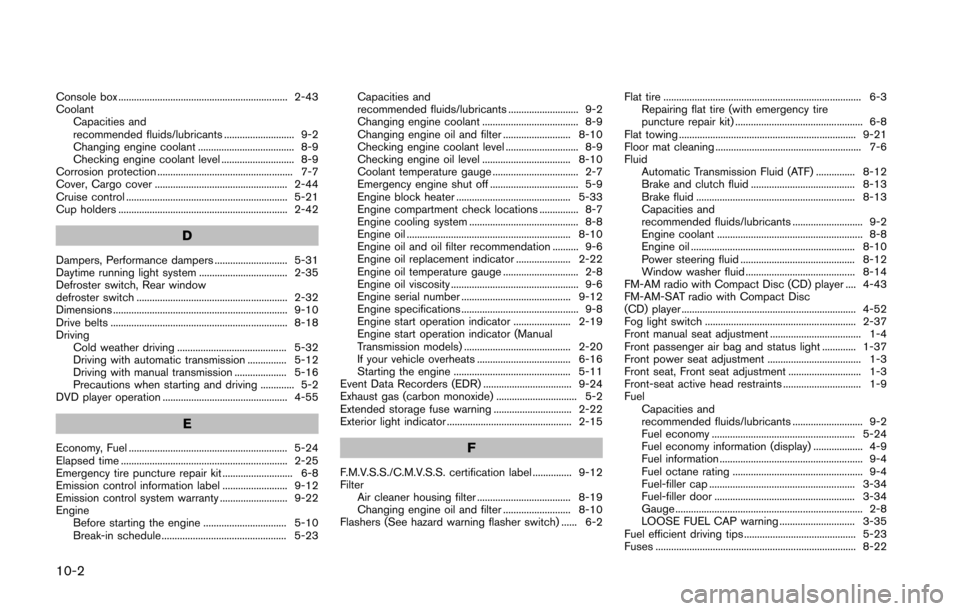
10-2
Console box ................................................................. 2-43
CoolantCapacities and
recommended fluids/lubricants ........................... 9-2
Changing engine coolant ..................................... 8-9
Checking engine coolant level ............................ 8-9
Corrosion protection .................................................... 7-7
Cover, Cargo cover ................................................... 2-44
Cruise control .............................................................. 5-21
Cup holders ................................................................. 2-42
D
Dampers, Performance dampers ............................ 5-31
Daytime running light system .................................. 2-35
Defroster switch, Rear window
defroster switch .......................................................... 2-32
Dimensions ................................................................... 9-10
Drive belts .................................................................... 8-18
Driving Cold weather driving .......................................... 5-32
Driving with automatic transmission ............... 5-12
Driving with manual transmission .................... 5-16
Precautions when starting and driving ............. 5-2
DVD player operation ................................................ 4-55
E
Economy, Fuel ............................................................. 5-24
Elapsed time ................................................................ 2-25
Emergency tire puncture repair kit ........................... 6-8
Emission control information label ......................... 9-12
Emission control system warranty .......................... 9-22
Engine Before starting the engine ................................ 5-10
Break-in schedule ................................................ 5-23 Capacities and
recommended fluids/lubricants ........................... 9-2
Changing engine coolant ..................................... 8-9
Changing engine oil and filter .......................... 8-10
Checking engine coolant level ............................ 8-9
Checking engine oil level .................................. 8-10
Coolant temperature gauge ................................. 2-7
Emergency engine shut off .................................. 5-9
Engine block heater ............................................ 5-33
Engine compartment check locations ............... 8-7
Engine cooling system .......................................... 8-8
Engine oil ............................................................... 8-10
Engine oil and oil filter recommendation .......... 9-6
Engine oil replacement indicator ..................... 2-22
Engine oil temperature gauge ............................. 2-8
Engine oil viscosity ................................................. 9-6
Engine serial number .......................................... 9-12
Engine specifications ............................................. 9-8
Engine start operation indicator ...................... 2-19
Engine start operation indicator (Manual
Transmission models) ......................................... 2-20
If your vehicle overheats .................................... 6-16
Starting the engine ............................................. 5-11
Event Data Recorders (EDR) .................................. 9-24
Exhaust gas (carbon monoxide) ............................... 5-2
Extended storage fuse warning .............................. 2-22
Exterior light indicator ................................................ 2-15F
F.M.V.S.S./C.M.V.S.S. certification label ............... 9-12
Filter Air cleaner housing filter .................................... 8-19
Changing engine oil and filter .......................... 8-10
Flashers (See hazard warning flasher switch) ...... 6-2 Flat tire ............................................................................ 6-3
Repairing flat tire (with emergency tire
puncture repair kit) ................................................. 6-8
Flat towing .................................................................... 9-21
Floor mat cleaning ........................................................ 7-6
Fluid Automatic Transmission Fluid (ATF) ............... 8-12
Brake and clutch fluid ........................................ 8-13
Brake fluid ............................................................. 8-13
Capacities and
recommended fluids/lubricants ........................... 9-2
Engine coolant ........................................................ 8-8
Engine oil ............................................................... 8-10
Power steering fluid ............................................ 8-12
Window washer fluid .......................................... 8-14
FM-AM radio with Compact Disc (CD) player .... 4-43
FM-AM-SAT radio with Compact Disc
(CD) player ................................................................... 4-52
Fog light switch .......................................................... 2-37
Front manual seat adjustment ................................... 1-4
Front passenger air bag and status light ............. 1-37
Front power seat adjustment .................................... 1-3
Front seat, Front seat adjustment ............................ 1-3
Front-seat active head restraints .............................. 1-9
Fuel Capacities and
recommended fluids/lubricants ........................... 9-2
Fuel economy ....................................................... 5-24
Fuel economy information (display) ................... 4-9
Fuel information ....................................................... 9-4
Fuel octane rating .................................................. 9-4
Fuel-filler cap ........................................................ 3-34
Fuel-filler door ...................................................... 3-34
Gauge ........................................................................ 2-8
LOOSE FUEL CAP warning ............................. 3-35
Fuel efficient driving tips ........................................... 5-23
Fuses ............................................................................. 8-22
Page 422 of 428
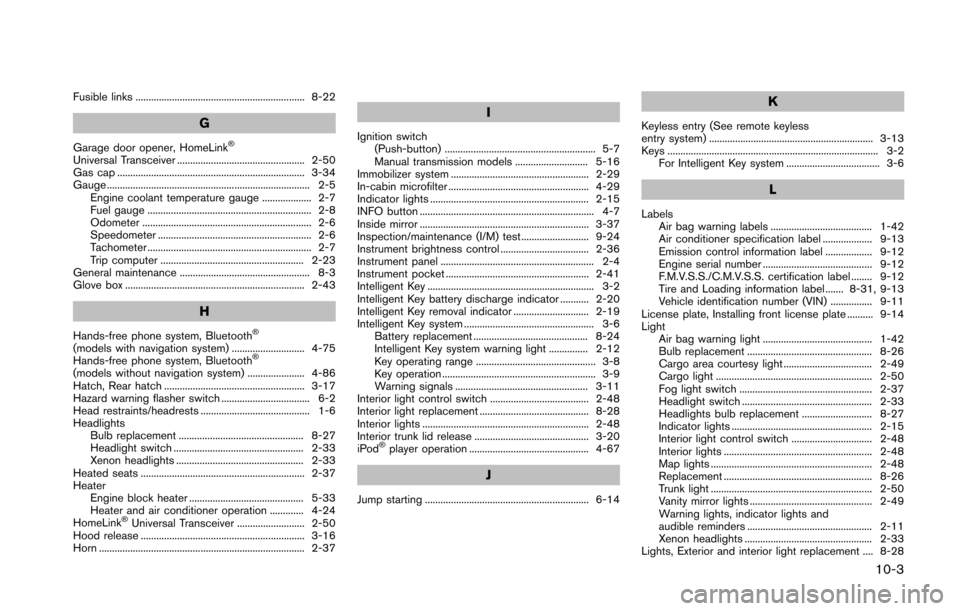
Fusible links ................................................................. 8-22
G
Garage door opener, HomeLink�Š
Universal Transceiver ................................................. 2-50
Gas cap ........................................................................ 3-34
Gauge .............................................................................. 2-5Engine coolant temperature gauge ................... 2-7
Fuel gauge ............................................................... 2-8
Odometer ................................................................. 2-6
Speedometer ........................................................... 2-6
Tachometer ............................................................... 2-7
Trip computer ....................................................... 2-23
General maintenance .................................................. 8-3
Glove box ..................................................................... 2-43
H
Hands-free phone system, Bluetooth�Š
(models with navigation system) ............................ 4-75
Hands-free phone system, Bluetooth�Š
(models without navigation system) ...................... 4-86
Hatch, Rear hatch ...................................................... 3-17
Hazard warning flasher switch .................................. 6-2
Head restraints/headrests .......................................... 1-6
Headlights Bulb replacement ................................................ 8-27
Headlight switch .................................................. 2-33
Xenon headlights ................................................. 2-33
Heated seats ............................................................... 2-37
Heater Engine block heater ............................................ 5-33
Heater and air conditioner operation ............. 4-24
HomeLink
�ŠUniversal Transceiver .......................... 2-50
Hood release ............................................................... 3-16
Horn ............................................................................... 2-37
I
Ignition switch (Push-button) .......................................................... 5-7
Manual transmission models ............................ 5-16
Immobilizer system ..................................................... 2-29
In-cabin microfilter ...................................................... 4-29
Indicator lights ............................................................. 2-15
INFO button ................................................................... 4-7
Inside mirror ................................................................. 3-37
Inspection/maintenance (I/M) test .......................... 9-24
Instrument brightness control .................................. 2-36
Instrument panel ........................................................... 2-4
Instrument pocket ....................................................... 2-41
Intelligent Key ................................................................ 3-2
Intelligent Key battery discharge indicator ........... 2-20
Intelligent Key removal indicator ............................. 2-19
Intelligent Key system .................................................. 3-6 Battery replacement ............................................ 8-24
Intelligent Key system warning light ............... 2-12
Key operating range .............................................. 3-8
Key operation ........................................................... 3-9
Warning signals ................................................... 3-11
Interior light control switch ...................................... 2-48
Interior light replacement .......................................... 8-28
Interior lights ................................................................ 2-48
Interior trunk lid release ............................................ 3-20
iPod
�Šplayer operation .............................................. 4-67
J
Jump starting ............................................................... 6-14
K
Keyless entry (See remote keyless
entry system) ............................................................... 3-13
Keys ................................................................................. 3-2 For Intelligent Key system .................................... 3-6
L
LabelsAir bag warning labels ....................................... 1-42
Air conditioner specification label ................... 9-13
Emission control information label .................. 9-12
Engine serial number .......................................... 9-12
F.M.V.S.S./C.M.V.S.S. certification label ........ 9-12
Tire and Loading information label ....... 8-31, 9-13
Vehicle identification number (VIN) ................ 9-11
License plate, Installing front license plate .......... 9-14
Light Air bag warning light .......................................... 1-42
Bulb replacement ................................................ 8-26
Cargo area courtesy light .................................. 2-49
Cargo light ............................................................ 2-50
Fog light switch ................................................... 2-37
Headlight switch .................................................. 2-33
Headlights bulb replacement ........................... 8-27
Indicator lights ...................................................... 2-15
Interior light control switch ............................... 2-48
Interior lights ......................................................... 2-48
Map lights .............................................................. 2-48
Replacement ......................................................... 8-26
Trunk light .............................................................. 2-50
Vanity mirror lights ............................................... 2-49
Warning lights, indicator lights and
audible reminders ................................................ 2-11
Xenon headlights ................................................. 2-33
Lights, Exterior and interior light replacement .... 8-28
10-3
Page 424 of 428
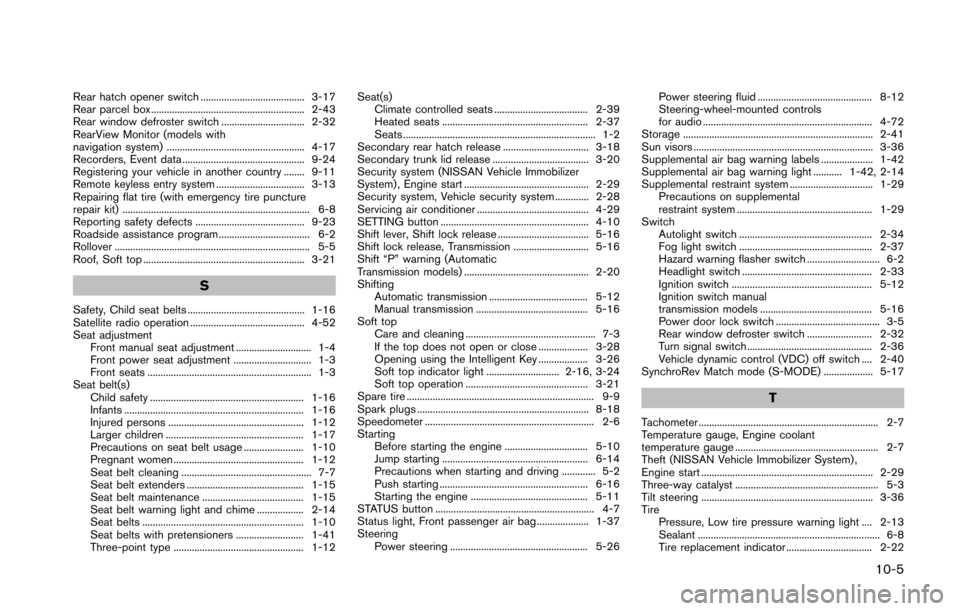
Rear hatch opener switch ........................................ 3-17
Rear parcel box ........................................................... 2-43
Rear window defroster switch ................................ 2-32
RearView Monitor (models with
navigation system) ..................................................... 4-17
Recorders, Event data ............................................... 9-24
Registering your vehicle in another country ........ 9-11
Remote keyless entry system .................................. 3-13
Repairing flat tire (with emergency tire puncture
repair kit) ........................................................................ 6-8
Reporting safety defects .......................................... 9-23
Roadside assistance program ................................... 6-2
Rollover ........................................................................... 5-5
Roof, Soft top .............................................................. 3-21
S
Safety, Child seat belts ............................................. 1-16
Satellite radio operation ............................................ 4-52
Seat adjustmentFront manual seat adjustment ............................. 1-4
Front power seat adjustment .............................. 1-3
Front seats ............................................................... 1-3
Seat belt(s) Child safety ........................................................... 1-16
Infants ..................................................................... 1-16
Injured persons .................................................... 1-12
Larger children ..................................................... 1-17
Precautions on seat belt usage ....................... 1-10
Pregnant women .................................................. 1-12
Seat belt cleaning .................................................. 7-7
Seat belt extenders ............................................. 1-15
Seat belt maintenance ....................................... 1-15
Seat belt warning light and chime .................. 2-14
Seat belts .............................................................. 1-10
Seat belts with pretensioners .......................... 1-41
Three-point type .................................................. 1-12 Seat(s)
Climate controlled seats .................................... 2-39
Heated seats ........................................................ 2-37
Seats .......................................................................... 1-2
Secondary rear hatch release ................................. 3-18
Secondary trunk lid release ..................................... 3-20
Security system (NISSAN Vehicle Immobilizer
System) , Engine start ................................................ 2-29
Security system, Vehicle security system ............. 2-28
Servicing air conditioner ........................................... 4-29
SETTING button ......................................................... 4-10
Shift lever, Shift lock release ................................... 5-16
Shift lock release, Transmission ............................. 5-16
Shift “P” warning (Automatic
Transmission models) ................................................ 2-20
Shifting Automatic transmission ...................................... 5-12
Manual transmission ........................................... 5-16
Soft top Care and cleaning .................................................. 7-3
If the top does not open or close ................... 3-28
Opening using the Intelligent Key ................... 3-26
Soft top indicator light ............................ 2-16, 3-24
Soft top operation ............................................... 3-21
Spare tire ........................................................................ 9-9
Spark plugs .................................................................. 8-18
Speedometer ................................................................. 2-6
Starting Before starting the engine ................................ 5-10
Jump starting ........................................................ 6-14
Precautions when starting and driving ............. 5-2
Push starting ......................................................... 6-16
Starting the engine ............................................. 5-11
STATUS button ............................................................. 4-7
Status light, Front passenger air bag .................... 1-37
Steering Power steering ..................................................... 5-26 Power steering fluid ............................................ 8-12
Steering-wheel-mounted controls
for audio ................................................................. 4-72
Storage ......................................................................... 2-41
Sun visors ..................................................................... 3-36
Supplemental air bag warning labels .................... 1-42
Supplemental air bag warning light ........... 1-42, 2-14
Supplemental restraint system ................................ 1-29 Precautions on supplemental
restraint system .................................................... 1-29
Switch Autolight switch ................................................... 2-34
Fog light switch ................................................... 2-37
Hazard warning flasher switch ............................ 6-2
Headlight switch .................................................. 2-33
Ignition switch ...................................................... 5-12
Ignition switch manual
transmission models ........................................... 5-16
Power door lock switch ........................................ 3-5
Rear window defroster switch ......................... 2-32
Turn signal switch ................................................ 2-36
Vehicle dynamic control (VDC) off switch .... 2-40
SynchroRev Match mode (S-MODE) ................... 5-17
T
Tachometer ..................................................................... 2-7
Temperature gauge, Engine coolant
temperature gauge ....................................................... 2-7
Theft (NISSAN Vehicle Immobilizer System) ,
Engine start .................................................................. 2-29
Three-way catalyst ....................................................... 5-3
Tilt steering .................................................................. 3-36
Tire Pressure, Low tire pressure warning light .... 2-13
Sealant ...................................................................... 6-8
Tire replacement indicator ................................. 2-22
10-5